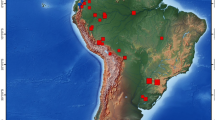Abstract
The pattern of phenotypic and molecular variation within the polytypic olivaceous warbler H. pallida was examined. This species is distributed in the southern parts of the western Palaearctic, central Asia and in the arid parts of northern Africa, and also in parts of the sub-Saharan Sahel zone. Based on morphology, five subspecies, at times assigned to three groups, have been identified. By comparing morphological, behavioural, vocal and molecular variation, we investigated the phenotypic and phylogenetic relationships within the Hippolais pallida group. The morphological and genetic data of the present study support the view of splitting the olivaceous warbler into a western (former subspecies opaca) and an eastern form (former subspecies elaeica, pallida, reiseri and laeneni). Opaca is consistently and significantly larger than the other taxa in all size measurements, even if it does share morphological properties with elaeica in characters associated with migration. The song of the polytypic pallida differs clearly from that of opaca, and is remarkably consistent within its wide range which comprises four subspecies. The molecular analysis, and the resulting phylogenetic pattern, clearly separated opaca on a single branch distant from the other subspecies. The eastern form consists of two non-overlapping haplotype groups: elaeica with relatively diverse mtDNA variation, and the three African subspecies pallida, reiseri and laeneni, which all share the same or closely related mtDNA haplotypes. It remains open whether the African taxa should be regarded as three valid subspecies of the Eastern olivaceous warbler, or if they are better treated as a single African subspecies.


Similar content being viewed by others
References
Ash J, Pearson D (2002) Hippolais warblers apparently breeding on the north Somalia coast. Bull Br Ornithol Club 122:222–228
Baker K (1997) Warblers of Europe, Asia and North Africa. Helm, London
Chappuis C (2000) African bird sounds. Société d’Études Ornithologiques de France
Ferguson JHW (2002) On the use of genetic divergence for identifying species. Biol J Linn Soc 75:509–516
Cramp S (ed) (1992) The birds of the western Palearctic, vol VI. Oxford University Press, Oxford
Gasse F (2000) Hydrological changes in the African tropics since the Last Glacial Maximum. Q Sci Rev 19:189–211
Hall TA (1999) BioEdit: a user-friendly biological sequence alignment editor and analysis program for Windows 95/98/NT. Nucleic Acids Symp Ser 41:95–98
Helbig AJ (2003) Evolution of bird migration: a phylogenetic and biogeographic perspective. In: Berthold P, Gwinner E, Sonnenschein E (eds) Avian migration. Springer, Berlin Heidelberg New York, pp 3–20
Helbig AJ, Seibold I (1999) Molecular phylogeny of Palearctic-African Acrocephalus and Hippollais warblers (Aves: Sylviidae). Mol Phylogenet Evol 11:246–260
Kocher TD, Thomas WK, Meyer A, Edwards SV, Pääbo S, Villablanca FX, Wilson AC (1989) Dynamics of mitochondrial DNA evolution in animals: amplification and sequencing with conserved primers. Proc Natl Acad Sci USA 86:6196–6200
Kumar S, Tamura K, Jacobsen IB, Nei M (2001) MEGA 2: molecular evolutionary genetics analysis software [2.1]. Arizona State University
Leisler B, Heidrich P, Schulze-Hagen K, Wink M (1997) Taxonomy and phylogeny of reed warblers (genus Acrocephalus) based on mtDNA sequences and morphology. J Ornithol 138:469–496
Nichols R (2001) Gene trees and species trees are not the same. Trends Ecol Evol 16:358–364
Pèrez-Tris J, Bensch S, Carbonell R, Helbig A J, Tellería JL (2004) Historical diversification of migration patterns in a passerine bird. Evolution 58:1819–1832
Shirihai H, Gargallo G, Helbig AJ (2001) Sylvia Warblers. Identification, taxonomy and phylogeny of the genus Sylvia. Helm, London
Sibley CG, Monroe BL (1990) Distribution and taxonomy of the birds of the world. Yale University Press, New Haven
Sibley CG, Monroe BL (1993) A supplement to distribution and taxonomy of the birds of the world. Yale University Press, New Haven
Svensson L (1992) Identification guide to european passerines, 4th edn. Stockholm
Svensson L (2001) Identification of western and eastern olivaceous, booted and Sykes’s warblers. Birding World 14:192–219
Urban EK, Fry HC, Keith S (1997) The birds of Africa, vol V. Academic, San Diego
Wilkinson L (1992) SYSTAT for Windows 10.0. SYSTAT, Evanston
Acknowledgments
The Nigerian part of the project was funded by the Erna and Victor Hasselblad Foundation, the Carl Trygger Foundations and Ottenby Bird Observatory (Sweden), Vogelwarte Helgoland (Germany), and the Wetland Trust (UK). We received extensive logistic support in Nigeria from Mr. A.P. Leventis and from the Lake Chad Research Institute. We thank Mr. Philip Hall for his invaluable organisational help, and the Nigerian Conservation Foundation. Jared Wilson kindly provided recordings of laeneni made close to the ringing site in Malamfatori. The late Michael King, who ran a program funded by the Wetland Trust (UK), kindly provided the data from The Gambia. Christian Hjort contributed valuable comments on earlier drafts of this paper. Much of the fieldwork in Kazakhstan and Morocco undertaken by LS was done in close cooperation with Andrew Lassey and Mike Pearson, and they are thanked for much practical help and inspiring discussions. Others who helped were Edward Gavrilov, Andrew Grieve and D.I.M. Wallace. While in Bulgaria, valuable help was received by Svetla Dalakchieva, Ola Jörnstedt, Boris Nikolov and Konstantin Popov. In Egypt, L.S. was helped by Mindy Baha El Din and Wed Ibrahim. In Tunisia, L.S. was helped by Lena Rahoult, Göran Ahlgren and others. For much assistance and help in connection with research in museum collections, L.S. thanks the curators and staffs at the natural history museums in Almaty, Copenhagen, New York, Paris, St. Petersburg, Stockholm, and Tring. A special thank to Claire Voisin and the Musée National d’Histoire Naturelle in Paris for providing tissue of reiseri for the DNA analysis. This is contribution no. 195 from Ottenby Bird Observatory.
Author information
Authors and Affiliations
Corresponding author
Additional information
Communicated by F. Bairlein
Rights and permissions
About this article
Cite this article
Ottosson, U., Bensch, S., Svensson, L. et al. Differentiation and phylogeny of the olivaceous warbler Hippolais pallida species complex. J Ornithol 146, 127–136 (2005). https://doi.org/10.1007/s10336-004-0071-4
Received:
Revised:
Accepted:
Published:
Issue Date:
DOI: https://doi.org/10.1007/s10336-004-0071-4




